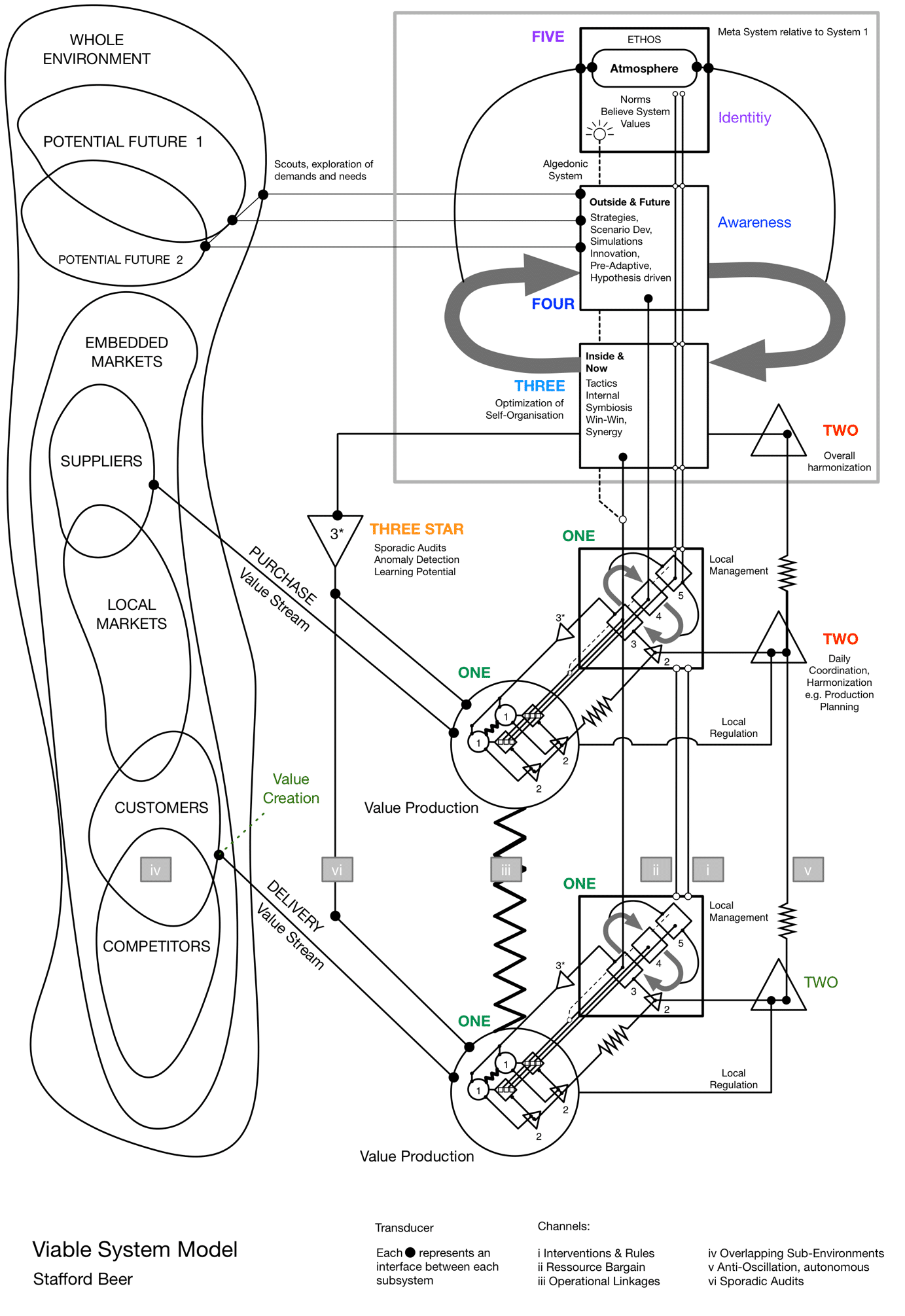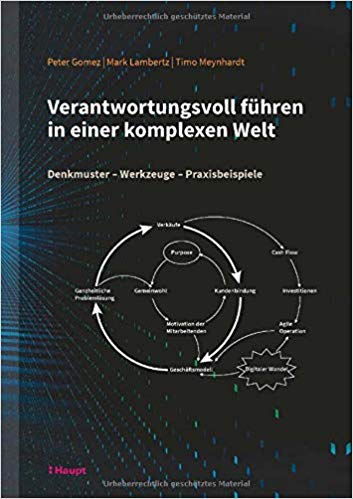The Viable System Model and responsible leadership
Table of Contents
1. The optimal simplification of complexity
2. The perspective of the Russian dolls
3. The unity of freedom and responsibility
4. At the centre the human being
5. The holistic measurement of success
System 1: The place of value creation
System 2: The local and overall coordination of daily business
System 3: The management of current business
System 3*: Audits, Intro- and Retrospectives
System 4: Exploring possible futures
System 5: The identity of the organisation
Viable System Model – visualisation and structure
Five core statements are intended to give you an impression of the framework of thought to enable you to start the following extract:
- Responsible leadership is defined by the concept of viability. Only if the viability of the organisation and society is maintained can leadership be understood as a responsible task.
- The autonomy of the smallest unit may only be restricted if the larger whole is at risk. The art of responsible leadership is to give autonomy a chance even in difficult times.
- Do not trust the organisation chart, look for those who contribute something to the greater whole.
- The best idea wins – titles and positions are secondary in developing solutions.
- Whoever contributes leads.
All these aspects are explained in the book using the Viable System Model. Please do not be confused by the different system names mentioned in the excerpt and simply “overlook” them. At the end of this article there is a crash course in the model to give you a first introduction.
Towards the end of the book, we offer a comprehensive list of questions that can be used by “reflective practitioners” to find out whether they meet our “standards”. Once questions are submitted based on five patterns of thought, and then these are deepened with the help of the Viable System Model. There are 92 questions in total. Of course, this list does not claim to be complete, since it is a rather complex topic. Nevertheless, this list of questions could be helpful to integrate viability as a guiding star of responsible leadership into everyday life.
Book excerpt:
1. The optimal simplification of complexity
The following questions arise during self-management:
- Do I resist the temptation to characterise complex problems as “this is nothing but” so that I can apply my usual methods?
- Am I aware that “Big Data” provides large amounts of data on the parts of a system, but largely hides their links?
- Do I simplify complex problems in such a way that their character and content are not lost?
- Do I have the tools to deal with complexity creatively and purposefully?
The following questions arise during leadership in organisations:
- Do we have the necessary diversity and creativity among our employees, appropriate to the complexity of the situation?
- With “Big Data”, do we not blindly rely on machines, but hand over responsibility for the functioning of the whole to employees?
- Is our company organised in such a way that the required diversity of leadership is ensured across all levels – which means that the requirements of the Viable System Model are met?
- Do we follow the fundamental insight that as the complexity of the whole increases, the parts must be loosely coupled?
2. The perspective of the Russian dolls
The following questions arise during self-management:
- Do I always keep an eye on the embedding in the bigger picture when making decisions?
- Do I follow a “helicopter view” approach, a constant oscillation between my own goals and the demands of the company, the economy and society?
- Am I aware that there can be no exact prognosis of economic and social development?
- Do I consistently implement the principle of subsidiarity, the autonomy of the smallest unit?
The following questions arise in leadership in organisations:
- Are our employees trained and able to think in larger contexts?
- Do we organise and lead according to the principle of distributed intelligence, so that decisions are prepared and taken where the greatest competence exists?
- Are meeting agendas designed in such a way that opportunities discovered in the wider environment have priority over internal problems?
- Is there contingency planning for decisions when “the system” strikes back?
3. The unity of freedom and responsibility
The following questions arise during self-management:
- How do I, as a manager, use my freedom and take full responsibility?
- Does effectiveness (“doing the right things”) have priority over efficiency (“doing things right”)?
- Do I respect the autonomy of the smallest unit?
- Do I create synergy effects between my different roles, while at the same time being able to combine them with my personal concerns in a productive way?
- How do I deal with risks, how do I tolerate mistakes (including my own)?
The following questions arise during leadership in organisations:
- Do we allow for diversity of opinions and do we create a culture of trust?
- Do we make job rotation and job enrichment a principle for understanding the bigger picture in the company?
- Does our company provide equal opportunities for our employees in the sense of fair conditions?
- How do we make use of the scope for freedom within the company and do we take full responsibility for it?
4. At the centre the human being
The following questions arise during self-management:
- “Avoid harm” – do I follow the Hippocratic oath even on new subjects such as artificial intelligence?
- Am I aware that terms like freedom, power and politics have to be redefined in the age of networks?
- How do I take into account the increasing dependence on machines, which pushes creative thinking into the background?
- Do I maintain a critical distance from developments that ultimately undermine human freedom?
The following questions arise in leadership in organisations:
- Do human talents like creativity, empathy, feeling, physicality and insight take precedence over the impressive computing power of machines?
- Do we enable our employees to learn and develop permanently?
- When filling new positions, do our own employees have priority over external specialists?
- Are privacy, transparency and security guaranteed when using artificial intelligence?
5. The holistic measurement of success
The following questions arise during self-management:
Do I basically lead with numbers, or am I also prepared to allow soft factors in measuring success?
Am I familiar with the various approaches to measuring success, as well as their strengths and weaknesses?
Does the primary obligation to the common good coincide with my inner compatibility?
How do I use the freedom to align my business model with public value?
The following questions arise in leadership in organisations:
Is our measurement system designed in such a way that the various stakeholders, each with their own interests, are reflected in it?
Is the way in which objectives are set and success measured an incentive or an obstacle for employees?
How can the contribution to the common good be anchored in the company as a regulatory idea?
Should the shareholders, in addition to the board of directors/supervisory board and management, also commit themselves to the company’s social contribution?
Following these initial overarching guiding questions, the questions relevant to leadership must now be formulated for the individual systems of the Viable System Model, differentiating between self-management and leadership in organisations.
System 1: The place of value creation
The following questions arise during self-management:
- Do I know my different roles as a manager, colleague, family member, friend?
- As a responsible person, am I able to manage my business unit autonomously in all dimensions?
- Do I know the expectations of the customers and is my value chain consistently aligned with them?
- Do I have the operational framework in place to fulfill my roles?
- Are my “leadership reflexes” right when processes do not work?
The following questions arise when leading in organisations:
- Are our business units viable because they create immediate value for customers? And, in principle, could they maintain viability on their own?
- Do our business units have the necessary resources and freedom to do so, and do they have a management team with the necessary talents and skills?
- Is the unit in regular contact with the client to listen to him or is it just speculation?
- Does the unit have a shared understanding of how to inspire existing and new customers?
System 2: The local and overall coordination of daily business
The following questions arise during self-management:
- As the person responsible for a business unit, am I personally prepared to provide information and time resources for informal coordination with the other units?
- Do I resist the temptation to elegantly “offload” cumbersome infrastructure tasks in the process?
- How consistently do I design “time-boxing” and am I able to prioritise at short notice?
- Do I know my golden corridor of day-to-day business and development tasks that will let me get into a “flow”?
The following questions arise during leadership in organisations:
- Do we organise the coordination of the business units – beyond the specifications of the “command axis” – in such a way that fluctuations in operations are avoided through mutual informal support?
- Do we have a system of key performance indicators (KPIs) that can quickly identify potential weaknesses in productivity and capacity bottlenecks in the business units and develop countermeasures?
- Is the current performance/capacity of the unit known? Can reliable forecasts be made regarding the consequences of reprioritisation?
- Is the system 2 listened to? Is the relevance of autonomous harmonisation at the level of day-to-day business ensured in order to be able to exploit development potential at all?
System 3: The management of current business
The following questions arise during self-management:
- Do I have the necessary resources (time, strength, skills) to contribute to the successful operational management of the entire company?
- Do I involve those responsible for achieving the profit targets in the “engine room” in a way that takes into account their interests and “rituals” and motivates them in the best possible way?
- While giving priority to efficiency, do I also build in enough buffer to be able to optimally satisfy customer needs?
- Do I create synergy effects between my different roles while at the same time being able to combine them with my personal concerns in a productive way?
- Do I set the right priorities in the medium term?
The following questions arise during leadership in organisations:
- How do we design this management level in such a way that a healthy medium-term profit development of the company results?
- How do we achieve an optimal alignment of the medium-term profit planning with the strategic orientation of the company?
- How do we coordinate the medium-term planning process of the entire company with the planning and coordination of day-to-day business without micromanagement limiting the autonomy of the subunits?
- Are the strategic goals clear (System 4) so that the right decisions can be made at the level of day-to-day business?
System 3*: Audits, Intro- and Retrospectives
The following questions arise during self-management:
- How do I prevent self-exertion (e.g. burnout, lack of sleep) and self-deception (loss of reality)?
- Do I make sure that unexpectedly occurring errors in the system are detected by my own warning signals – and not by the customers?
- How can I design this warning system in such a way that the trust of those responsible for operations is not damaged?
- Do I take time for introspection, do I allow myself to recognise my own errors, can I forgive myself and learn from it?
- Do I have friends who, through honest feedback, help me to reflect critically on myself?
The following questions arise during leadership in organisations:
- How do we develop a corrective beyond the “command axis” – analogous to the informal coordination of day-to-day business – that allows “filtered information” to be recognised and sends warning signals early on?
- How do we ensure that this warning system is committed to neutrality and serves the well-being of the entire company?
- Do the managers only know the “engine room” from Excel charts, or are they (in time) on the spot?
- Is there a climate in which a fact-based investigation of the causes of major disruptions is seen as an enrichment?
System 4: Exploring possible futures
The following questions arise during self-management:
- Do I make use of my opportunities to contribute what I have “correctly identified” to the long-term development of the company?
- How can I holistically grasp the environment in its contexts so as not to develop strategies that simply perpetuate the status quo?
- How do I transform inventions into innovations by linking the strategy and operations?
- How do I achieve a change of perspective in myself and motivate others to do so?
- How do I incorporate the determining factors of social value contribution into my considerations?
The following questions arise during leadership in organisations:
- How do we ensure that all activities for the development of the company are not only coordinated among each other and across all hierarchical levels, but also driven in constant interaction with the environment?
- How do we ensure that “the power of the wheels is put on the road”, that the interaction between operational and strategic management functions optimally?
- How do we use the tools of networked thinking in such a way that thinking in cycles becomes the standard for the process of strategy development?
- How do we develop an early detection system for environmental developments that will determine the future as megatrends?
System 5: The identity of the organisation
The following questions arise during self-management:
- When did I last think about my values, my “purpose” and my goals, and how do they relate to the company’s goals?
- Am I able to articulate my own purpose and communicate it to others?
- What does “Walking the Talk” mean to me in relation to the corporate values that uphold the common good?
- Do I also constantly question myself by allowing feedback to reach me that contains criticism? Do I actively seek it? Am I willing and able to place my actions in a larger context of social references and philosophical perspectives?
The following questions arise in leadership in organisations:
- Can we even name our purpose? If not, why not?
- How can we ensure that the company’s purpose gives first priority to contributing to the common good?
- How can we ensure that the communicated purpose of the company is consistent with the real purpose (POSIWID)? Are we able to establish the connections with the larger whole in our everyday business (recursiveness)?
- What mechanisms do we need to productively resolve possible conflicts of values?
If you are now curious and would like to learn more about the Viable System Model, this short introduction might give you an idea of what it is all about. First, the visualisation of the model to give you an impression of its beauty and elegance. A closer look will allow you to discover the fractal nature of the model.
Viable System Model – visualisation and structure
Environment: No system can exist without its corresponding environment. And: There would be no environment if there were no embedded system. Both aspects are structurally coupled.
System 1: This subsystem is responsible for producing and delivering added value for its customers. It is called an operation and works in (relative) autonomy.
System 2: Balances the activities of system 1. It is responsible for harmonising the production flow. One could speak of the regulatory nature of this subsystem.
System 3: Has a privileged position in the model because it monitors the activities of all systems 1. It is responsible for the “fair” distribution of resources and rules. It is responsible for the medium-term results of the organization.
System 3*: This subsystem ensures that “blind spots” are detected. Originally Stafford Beer called it the audit channel. In the context of knowledge work I prefer to use the term “retrospective system”.
System 4: This subsystem is responsible for exploring the environment and developing strategies and scenarios for the organisation. Therefore it is also the place for innovation and has the long-term development of the “whole” in mind.
System 5: The ultimate authority of the organisation, as this system defines the identity. Even though it is far from the company (System 1), it is responsible for all actions of the system. It balances the interests of the “inside and now” (system 3) and the “outside and then” (system 4).
I wish you happy thinking!
Notes:
For the authors, “responsible leadership” means securing, promoting and developing the viability of companies, teams and, last but not least, each individual. This creates the conditions for sustainable success in the complex environment of digital change.

Mark Lambertz
Mark Lambertz has been a digital native since he learned programming with his first Apple computer at the age of 12. In 1995 he founded one of the first digital agencies in Germany and voluntarily left after 20 years. Today he advises and coaches managers and teams as an Agile Master at METRONOM (IT subsidiary of Metro AG).

